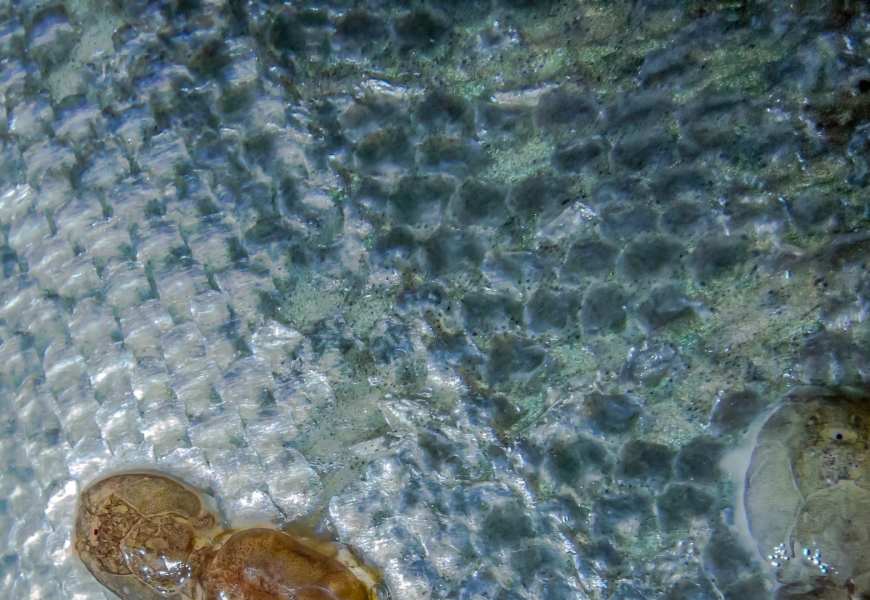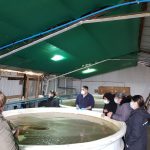After sequencing the entire genome of the Caligus rogercresseyi, the team from the “Aquaculture Genome” area of the INCAR Center is approaching a second important achievement: developing the first vaccine to control this ectoparasite
By Edgardo Vera / edgarvera@udec.cl / Photographs: INCAR
Caligidosis is an illness caused by the ectoparasite known as sea lice (Caligus rogercresseyi), which causes major losses in the Chilean salmon industry. Nowadays, the illness is mainly treated using
antiparasitic drugs, whose effectiveness has fallen in recent years. This would be about to change, since a group of researchers from the Interdisciplinary Center for Aquaculture Research
(INCAR, in Spanish), has developed a vaccine, called “iPath®”. Using experimental tests on Atlantic salmon, the researchers have shown a promising application of this vaccine to fight caligidosis.
According to the team led by the Deputy Director of INCAR and Professor of the Department of Oceanography of Universidad de Concepción (UdeC), Cristian Gallardo Escárate Ph.D., and formed by Valentina Valenzuela Muñoz Ph.D., Gustavo Nuñez Acuña Ph.D, Diego Valenzuela Miranda Ph.D., Bárbara Benavente, Constanza Sáez Vera, Antonio Casuso, and Yeni Leal, all from the “Aquaculture Genome” line of INCAR, the vaccine developed is based on a recombining chimerical protein, with an iron burning activity, which would significantly reduce the parasitic loads of Caligus rogercresseyi in Atlantic salmon. On the other hand, the researchers have shown that this
vaccine delays the mortality curves in fish infected by bacteria such as Aeromonas salmonicida and Piscirickettsia salmonis.
“When we opened the INCAR Center in 2012, one of the main challenges was reducing the knowledge gaps on Caligidosos control methods, the most common illness in the Salmon industry. Little by little, we started generating knowledge on the genome of parasites and fish, and by 2016, after having published the complete transcriptome of Caligus, we began to develop the vaccine”, the Deputy Director and Lead Researcher of the “Aquaculture Genome” line of INCAR, Cristian Gallardo Escárate Ph.D., explains.
“Vaccines allow reducing the use of drugs or antibiotics for bacteria treatment, which benefits the sustainability of the industry and the environment. This is because the treatments are made
directly on the cages where the fish are farmed. In the case of antibiotics, although these are given through food, there is a risk of antibiotic-resistant bacteria being generated in the sea”, explained the adjunct researcher of INCAR, Valentina Valenzuela Muñoz Ph.D., emphasizing
that there is no commercial vaccine today to control Caligus. “According to our studies, this vaccine reduces the essential nutrients for the development of Caligus in the fish’. We have also seen that, on being an iron burner, it generates an adverse environment for bacteria that affect salmon farming”.
Dr. Gallardo Escárate also highlights that, to generate the vaccine, “we started from the molecular information we had on the parasite. This is because, on being an ectoparasite, it attaches itself to the fish’s skin, but does not enter its blood and organism. For this reason, the use of this recombining protein, and having found these molecules, are the key aspects in the infection process, making it unique in the world”, he expressed.
The researchers evaluated the protection capacity of IPath® in salmon against an experimental infection with Aeromonas salmonicida, and another group infested with Caligus rogercresseyi, followed by an infection with Piscirickettsia salmonis, using in vivo tests. The vaccinated fish
showed a reduction in the parasitic load of close to 96%. “We observed an average load of 17 lice in the group of fish vaccinated, in comparison with an average load of 407 lice in the control group”, the experts clarified. A delay was also seen in the mortality curves of the vaccinated fish
infected with P. salmonis.
On the other hand, it was seen that the sea lice retrieved from the immunized fish, experienced changes in the development of their ovigerous sacks and gene expression in the reproduction processes, such as vitellogenin, “which suggests that IPath® can alter reproduction in the caligus exposed to vaccinated fish. This would help to reduce the number of larvae of the ectoparasite, and thus the likelihood of a later infestation in the fish farms”, they suggested.
IPath® is still in its experimental phase, and four different tests have been run on the effect of the vaccine on Caligus infestation, all run in the experimental laboratory that the “Aquaculture Genome” research line of the INCAR Center has, in Dichato. However, the effects are promising. “Field tests need to be run to evaluate whether the results are similar to those seen under controlled laboratory conditions. It is also necessary that a company with the capacity to generate the vaccine in high amounts is interested in licensing our development, so it can be sold”, Dr. Gallardo Escárate stated.
For more information:
Cristian Gallardo Escárate Ph.D. crisgallardo@oceanografia.udec.cl
Valentina Valenzuela Muñoz Ph.D. valevalenzuela@udec.cl
www.centroincar.cl







